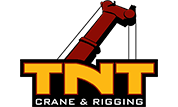Tips for Heavy Lifting with a Crawler Crane
Crawler Cranes | May 27 / 25
When it comes to lifting heavy loads on challenging job sites, crawler cranes are one of the most reliable pieces of equipment available. Their stability and mobility across uneven terrain make them ideal for demanding construction and industrial projects; however, getting the best results means paying close attention to safety, planning, and technique. At TNT Crane & Rigging, we want to help you get the best results for your project. That is why we have put together some essential tips for heavy lifting with a crawler crane.
Learn how to properly plan for lifting heavy machinery.
1. Start with a Clear Lift Plan
Every successful lift starts with proper planning. Assess the site, determine the weight and dimensions of the load, and select the right crane configuration for the job. Whether you are hoisting materials or installing heavy industrial equipment, a detailed lift plan ensures smoother operations and minimizes risk. It is also important to consider potential hazards like weather conditions, ground stability, and nearby structures.
2. Ensure Proper Ground Preparation
Crawler cranes rely on a stable surface to perform safely. Soft or uneven terrain can compromise the crane’s balance and lifting capacity. Before setting up, it is important to take time to level the area, reinforce the ground, if needed, and check for any underground utilities that could be affected by the crane’s weight.
3. Follow Load Chart Guidelines
Each crawler crane has a unique load chart outlining its lifting capacities based on boom length, radius, and configuration. Make sure the crane is never pushed beyond its limits. Following the manufacturer’s load chart is essential not just for safety but also for streamlining crane operations, ensuring each lift is efficient, precise, and within the equipment’s capabilities. Cutting corners can lead to serious accidents or equipment damage.
4. Communicate Clearly Onsite
Heavy lifting projects involve multiple team members, and clear communication is critical. Ensure that signal persons, operators, and ground crew are on the same page with hand signals, radio protocols, and lift instructions. Proper coordination helps avoid delays and prevents mistakes during complex lifts.
5. Conduct Regular Equipment Checks
Before any lift, inspect the crane for signs of wear, leaks, or other issues. Routine maintenance and pre-lift inspections are a crucial part of preventing breakdowns and ensuring everyone’s safety onsite.
At TNT Crane & Rigging, we provide the expertise and equipment to support safe, reliable lifts across Canada. Contact us today to learn how we can help with your next project.
When it comes to lifting heavy loads on challenging job sites, crawler cranes are one of the most reliable pieces of equipment available. Their stability and mobility across uneven terrain make them ideal for demanding construction and industrial projects; however, getting the best results means paying close attention to safety, planning, and technique. At TNT Crane & Rigging, we want to help you get the best results for your project. That is why we have put together some essential tips for heavy lifting with a crawler crane.
Learn how to properly plan for lifting heavy machinery.
1. Start with a Clear Lift Plan
Every successful lift starts with proper planning. Assess the site, determine the weight and dimensions of the load, and select the right crane configuration for the job. Whether you are hoisting materials or installing heavy industrial equipment, a detailed lift plan ensures smoother operations and minimizes risk. It is also important to consider potential hazards like weather conditions, ground stability, and nearby structures.
2. Ensure Proper Ground Preparation
Crawler cranes rely on a stable surface to perform safely. Soft or uneven terrain can compromise the crane’s balance and lifting capacity. Before setting up, it is important to take time to level the area, reinforce the ground, if needed, and check for any underground utilities that could be affected by the crane’s weight.
3. Follow Load Chart Guidelines
Each crawler crane has a unique load chart outlining its lifting capacities based on boom length, radius, and configuration. Make sure the crane is never pushed beyond its limits. Following the manufacturer’s load chart is essential not just for safety but also for streamlining crane operations, ensuring each lift is efficient, precise, and within the equipment’s capabilities. Cutting corners can lead to serious accidents or equipment damage.
4. Communicate Clearly Onsite
Heavy lifting projects involve multiple team members, and clear communication is critical. Ensure that signal persons, operators, and ground crew are on the same page with hand signals, radio protocols, and lift instructions. Proper coordination helps avoid delays and prevents mistakes during complex lifts.
5. Conduct Regular Equipment Checks
Before any lift, inspect the crane for signs of wear, leaks, or other issues. Routine maintenance and pre-lift inspections are a crucial part of preventing breakdowns and ensuring everyone’s safety onsite.
At TNT Crane & Rigging, we provide the expertise and equipment to support safe, reliable lifts across Canada. Contact us today to learn how we can help with your next project.

